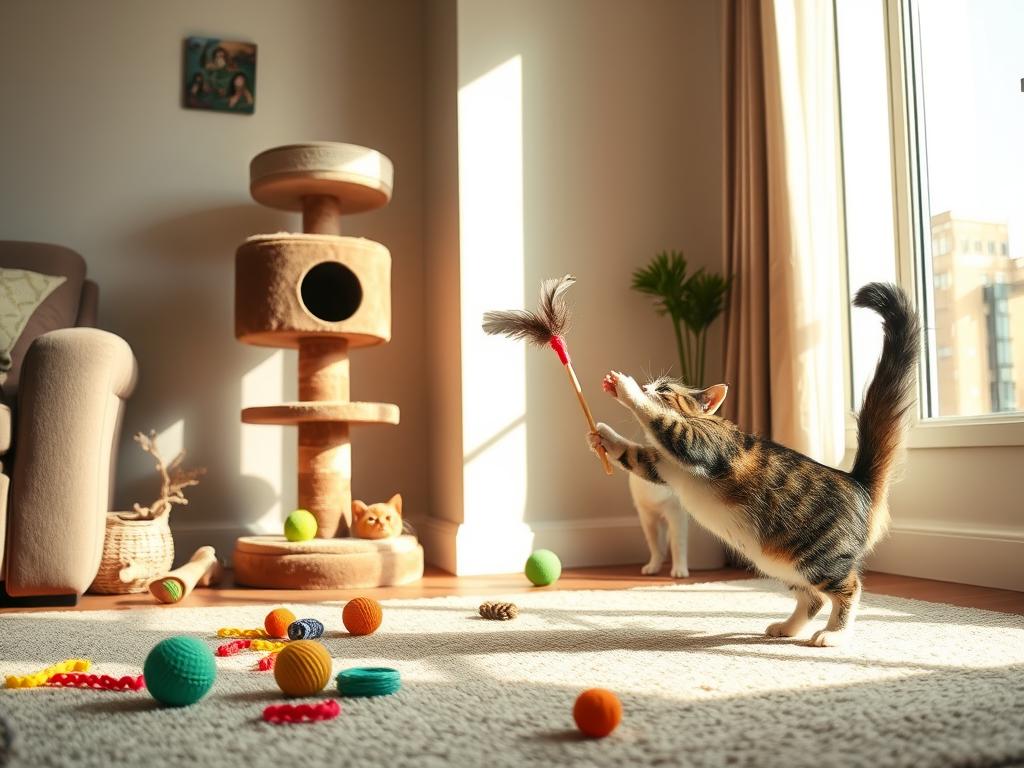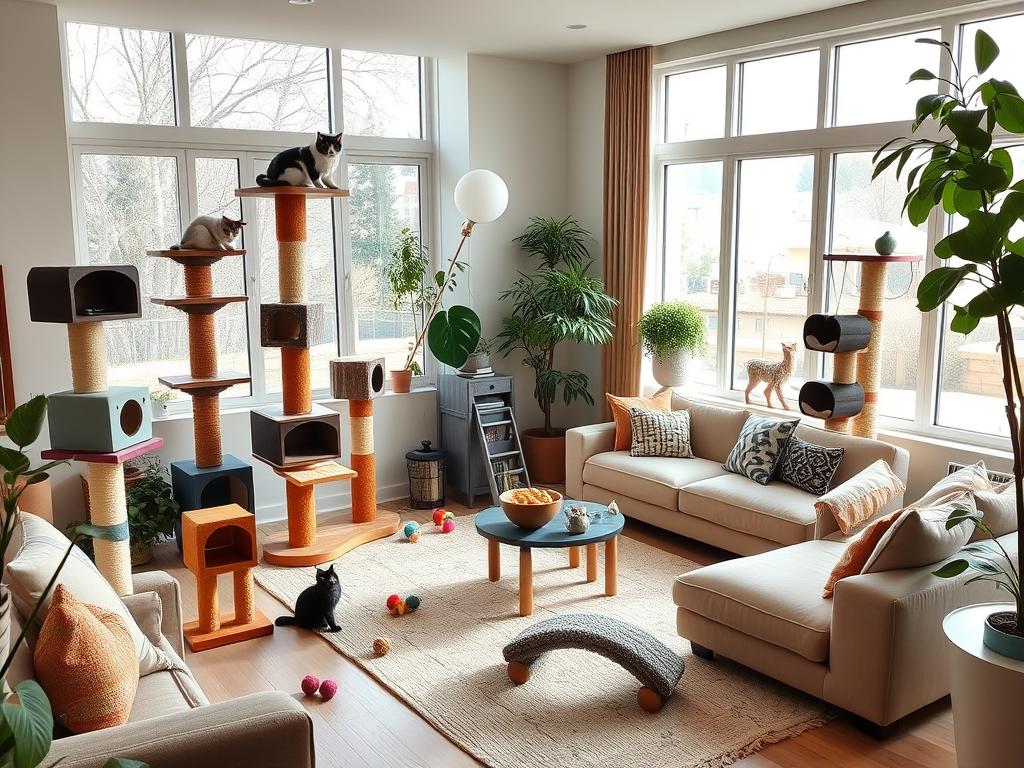“Affiliate Disclosure: Please note that some of the links on this website are affiliate links. This means that if you choose to make a purchase through these links, we may receive a small commission at no additional cost to you. This helps support the maintenance and continuation of our site. We assure you that we only recommend products or services we use personally or believe will add value to our readers. Thank you for your support.”
Getting your kitty to play does more than entertain—it’s a key to their health. Studies prove play boosts a cat’s wellbeing. It lets them tap into their instincts and keeps their minds sharp1. A cat that loves to play is usually happy and energetic. This strengthens your bond1. Here, we’ll explore five ways to make playtime with your cat fun and healthy. These tips will make playtimes more exciting and keep your furry friend in top shape!
Key Takeaways
- Playtime is crucial for your cat’s mental health and wellbeing.
- Engaging play reduces problem behaviors in cats, enhancing your relationship.
- Regular play helps maintain your cat’s energy levels and overall health.
- Understanding how to play with your cat can lead to a more rewarding experience.
- Incorporating physical and interactive toys can promote a fun environment.
- Setting a routine for playtime contributes to your cat’s happiness.
The Importance of Play for Cats
Playing with your cat is crucial for their health and happiness. It taps into their natural instincts to hunt, making them joyful. It’s more than just amusement; it’s essential for their well-being.
Understanding Cat Behavior
Watch your cat play and you’ll see signs of joy. They chase, pounce, and swat at toys, showing off their hunting prowess. Happy cats often result from regular play, leading to better social habits.
Benefits of Playtime for Mental Stimulation
Play keeps cats sharp. Sadly, over half of cat owners say they’re too busy for playtime2. Neglected cats might scratch or get aggressive2. Toys that stimulate them, like teaser toys, are a hit with about 70% of cats3.
Reducing Stress through Play
Playtime lowers stress for you and your cat. Studies show it can cut stress hormones by 40%3. An active cat is healthier and has fewer behavior problems, dropping by 28%3. Playing together also strengthens your bond2.
Creating an Engaging Environment
An engaging environment is key to your cat’s play and happiness. Start by making your home safe for exploring. Remove dangerous items and add fun toys and structures.
Tips for Cat-Proofing Your Home
Start cat-proofing by spotting hazards. Indoor cats often get bored, affecting their health and joy4. Keep toxic plants, fragile items, and tiny objects away. Choose sturdy furniture for your cat’s active moments.
Cat-Friendly Furniture Ideas
Choosing the right furniture makes your home a cat paradise. Sturdy cat condos and soft cushions are perfect for lounging and watching. Add modular climbing walls for fun and comfort5.
Incorporating Cat Climbing Trees
Cat climbing trees add excitement to your cat’s space. They allow for exercise and satisfy their climbing instinct. Vertical spaces like cat trees reduce anxiety by giving cats a high spot to view their domain6.
Top 5 Tips to Get Your Cat to Play
It’s important to keep your cat happy and healthy through play. By tapping into their natural instincts and creating stimulating activities, you can make playtime more fun for them. Here are some tips to boost your cat’s interest in playing.
Encouraging Natural Hunting Instincts
Activities that resemble hunting can trigger your cat’s desire to play. Games like hiding and seeking are great, as cats love to hunt for hidden treats or toys. This activity keeps their minds and bodies active. Experts say cats need 30-60 minutes of play daily for their well-being7.
Interactive and Engaging Toys
To catch your cat’s attention, use toys that imitate prey movements. Research finds that half of all cats show a preference for such toys7. Feather wands, laser pointers, and treat-dispensing toys are among the favorites. These toys not only get them moving but also make playing more satisfying. Surveys reveal that 75% of cat owners see their pets becoming more playful with interactive toys7.
Utilizing Simple Household Items
Don’t overlook everyday items for play. Things like paper bags and boxes can entertain your cat and stimulate their curiosity. And, letting them catch the toy reduces frustration by 37%7. Such games improve your cat’s physical activity and strengthen your bond with them.
Interactive Toys that Stimulate Play
Playing with interactive toys is essential for your cat’s health and joy. These toys bring fun and provide mental stimulation. They also ensure that cats get necessary exercise. Here are some cat toys that can make their playtime better.
Types of Engaging Cat Toys
- Interactive laser toys: Cats adore the unpredictable movement of laser beams. This makes these toys very popular for encouraging activity8.
- Cat puzzle feeders: These toys test your cat’s ability to solve problems, making them work for their treats. This helps with their digestion8.
- Treat-dispensing toys: They come with spaces for treats, rewarding your cat as they play. This promotes more lively play sessions8.
- Motion-activated toys: These toys move when your cat gets close, raising their curiosity. They keep your cat busy even when you’re not home8.
- Feather wands and teaser toys: By imitating birds, these toys offer a hunting challenge. Your cat will stay active8.
- Catnip-filled toys: With catnip inside, these toys increase your cat’s desire to play. They lift your cat’s energy levels8.
How to Introduce New Toys Gradually
When you introduce new toys, do it slowly. Start with one toy. Give your cat time to explore it before adding more. Watch how your cat plays to learn what they like. Then, choose toys that match their taste. Since every cat is different, it’s important to pick toys they enjoy89..
Fun Activities to Bond with Your Cat
You can create a strong bond with your cat by doing fun activities. These activities help keep your cat happy and healthy. By mixing up indoor and outdoor activities, you’ll match their natural instincts to their lifestyle.
Games to Play Indoors
Indoor games can turn your home into a cat’s playground. Try setting up an obstacle course with boxes and plastic tops to spark your cat’s curiosity10. Play with cat toys like feather wands or laser pointers to keep them interested. Each play session should be short, about 5 to 15 minutes11.
This keeps them engaged without getting tired. Have several playtimes throughout the day. This keeps their minds active and stops them from getting bored with different toys12.
Outdoor Playtime Considerations
Safety is key for outdoor playtime. Play in a safe area where your cat can explore and exercise12. Start slowly if your cat isn’t used to being outside. This can mean harness training for some or a calm, fenced area for others. Playing outside is good for their health and helps manage their weight. This is important because about 60% of U.S. cats are overweight10.
| Activity | Indoors | Outdoors |
|---|---|---|
| Obstacle Course | ✔️ | ✔️ |
| Interactive Toys | ✔️ | ❌ |
| Laser Pointer Games | ✔️ | ❌ |
| Exploration Walks | ❌ | ✔️ |
| Supervised Play | ❌ | ✔️ |
Recognizing Signs of a Happy Cat
Knowing how to tell if your cat is happy can make your bond stronger. Look for specific signs in their body language and sounds they make. This helps you know how they feel. You can then make sure they’re always happy and healthy.
Understanding Feline Body Language
Cats show they’re content in several ways. A happy cat often has its tail up with a little curl at the end. But a tail straight up might mean they’re upset. If they’re lying on their back or spread out, they probably feel safe and cozy13.
Kneading, or “making biscuits,” shows they’re feeling loving. About 70% of house cats do this to show affection13.
Indicators of Playfulness
Playful cats might purr or chirp a lot. This means they’re in a good mood. They use more than 60 different meows to talk to us13. Also, running around and playing shows they’re excited and want to play.
When a cat looks at you and slowly blinks, it’s like they’re giving you a ‘cat kiss.’ It’s their way of saying they like you13. Knowing these signs makes playtime more fun and helps you keep them happy.
Addressing Cats That Don’t Want to Play
It’s worrying when your cat doesn’t want to play. There are many reasons why this happens. Understanding them helps us find ways to make our cats playful again. We’ll look at how to soothe a stressed cat and tackle other reasons why they might not want to play.
How to Calm a Stressed Cat
A peaceful environment is key to your cat’s happiness. Cats need a quiet and safe place to start feeling playful. If your cat hides, acts aggressive, or grooms a lot, it might be stressed. Offering care and regular check-ups can improve their health and mood14. A happy atmosphere encourages them to play more.
Common Reasons for Disinterest in Play
Lack of interest in play can have many causes. Age and health issues are common factors. For example, indoor cats might not feel the need to hunt, which reduces their desire to play14. Stress from other cats in the home can also affect them. About 60% of homes with more than one cat notice this issue14. Choosing the right toys is crucial, with 70% of cats having toy preferences14. Knowing these reasons can guide us in making our cats happy and playful again.
Establishing a Routine for Playtime
It’s important to have a play routine for your cat to keep them happy. Cats are most lively at dawn and dusk. These times are perfect for playing1516. Regular playtimes let your cat look forward to fun activities and stay playful.
Setting Regular Play Sessions
Adult cats need two 15-minute play sessions each day17. Younger cats and kittens do best with shorter, more frequent playtimes—up to 10 might be good15. Use different toys and games to keep your cat excited and engaged.
Incorporating Play into Daily Care
Adding play to daily routines boosts your cat’s well-being. Use interactive toys and puzzles at meal times to make them think and eat slower16. This keeps them physically and mentally sharp, tapping into their instincts. Watch your cat for signs they need a break, like panting

By making playtime a routine, you will greatly improve your cat’s joy and health151617.
Conclusion
Playing with your cat is key to their health and happiness. It gives them a good mix of body and brain activity. Using the top 5 tips for cat play will change how you spend playtime. It lets you find joy and effective methods to make your cat play. These tips help you connect better and keep your cat happy and healthy by tapping into their natural behaviors and creating fun spaces.
Try to play with your cat for an hour each day, especially when they’re most awake and lively. Doing this helps your cat stay fit and prevents issues like scratching up furniture or other misbehaviors due to too much energy18. Using toys that get them moving and thinking can also boost their mood – and yours too, making everyone happier19.
Keeping these ideas in mind and using them regularly will not only cheer up your cat. It’ll also help avoid problems like anxiety and stress in your pet. So, dive into the playful side of life – your cat will be better for it, and you might find new joy in being together20!
FAQ
Q: Why is play important for my cat?
Q: How can I encourage my cat to play?
Q: What types of toys are best for my cat?
Q: How can I create a cat-friendly environment for play?
Q: What are some signs that my cat is happy and ready to play?
Q: My cat doesn’t seem interested in playing. What should I do?
Q: How often should I play with my cat?
Q: Can outdoor playtime benefit my cat?
Source Links
- https://www.sacramentocathospital.com/blog/the-joy-of-play-engaging-activities-to-keep-your-cat-happy-and-active/
- https://www.cozycatfurniture.com/blog/playing-with-cat?srsltid=AfmBOoq7JBvywja2trVh56vrZBgDisOy7NgDl8oO8vWE78PVB40ppXYw
- https://www.thesprucepets.com/how-to-play-with-your-cat-8696056
- https://oliveranimalhospital.com/5-creative-ways-to-enrich-your-indoor-cats-environment/
- https://www.fearfreehappyhomes.com/go-cat-crazy-how-to-craft-an-engaging-environment-for-feline-fun/
- https://www.animalhumanesociety.org/resource/seven-enrichment-ideas-keep-your-indoor-cat-entertained
- https://www.drelseys.com/2016/08/31/5-tips-cat-play/
- https://www.multipet.com/busy-day-8-toys-to-keep-your-cat-entertained-while-at-work/
- https://people.com/best-cat-toys-8579290
- https://www.catster.com/lifestyle/how-to-bond-with-your-cat-through-playtime/
- https://classactcats.com/blog/how-to-play-with-your-cat/
- https://caticles.com/how-to-treat-a-cat-activities-that-strengthen-your-bond/
- https://catinaflat.com/blog/how-to-know-if-your-cat-is-happy
- https://moderncat.com/articles/how-to-get-a-cat-to-play/
- https://www.petmd.com/cat/general-health/tips-for-keeping-your-cat-exercised-and-mentally-stimulated
- https://soykitty.com/blogs/news/maximizing-playtime-for-a-healthier-cat?srsltid=AfmBOoossmIawc8Ng-ZIO6ylIyqufE7pjb2rYFyHbXic1VH89LdznXKz
- https://www.armandhammer.com/articles/fun-ways-to-play-with-your-cat
- https://www.petmate.com/blogs/petmate-academy/how-to-play-with-your-cat
- https://www.catster.com/cat-health-care/how-to-play-with-your-cat/
- https://www.pumpkin.care/blog/how-to-train-a-cat/





